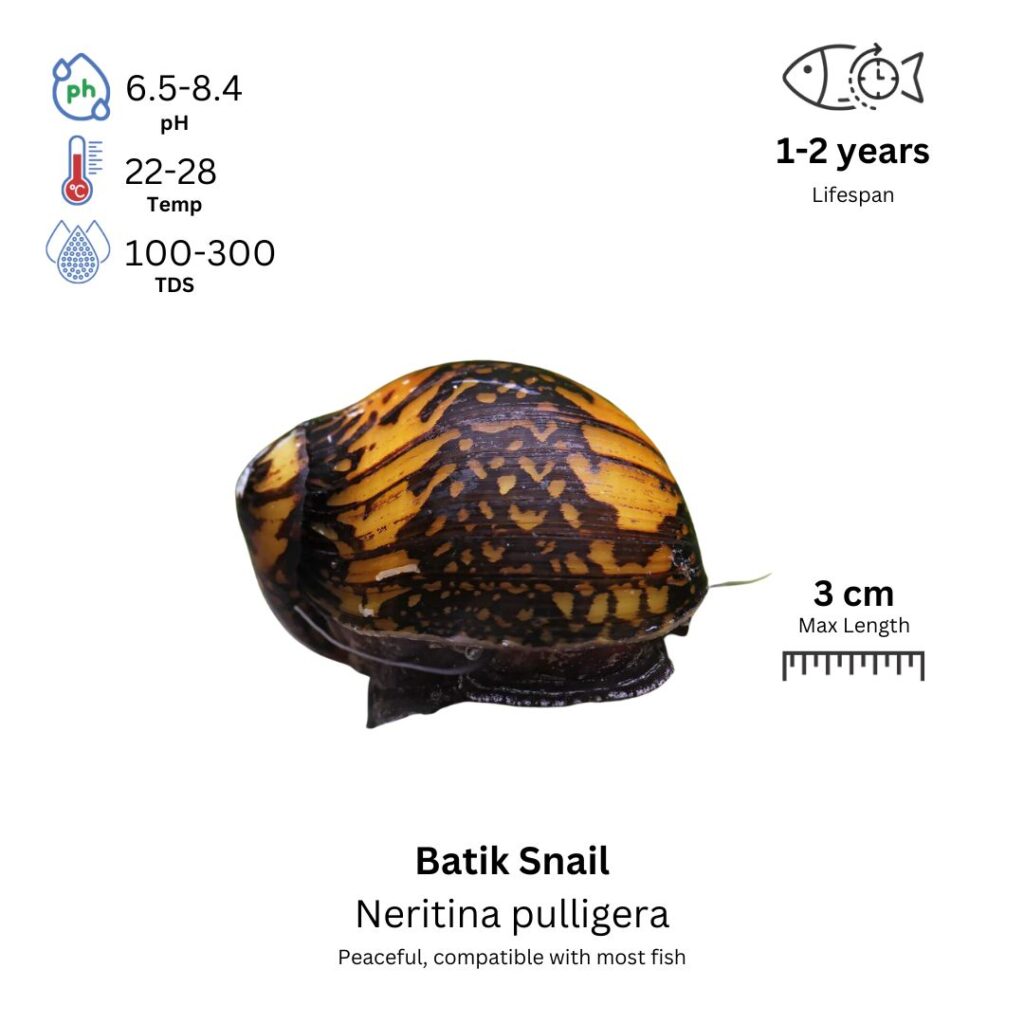Batik Snail
Clithon corona

Description
The Batik Snail is a freshwater species known for its beautiful and distinctive shell pattern, which resembles batik fabric, giving it the name “Batik Snail.” The shell is typically dark with contrasting light or yellowish markings, creating a unique, spiral design. The shell is relatively small and conical, and the snail’s body is usually dark with a slightly translucent appearance. Batik Snails are peaceful and slow-moving, spending much of their time grazing on algae, biofilm, and detritus. Their striking appearance and small size make them a popular choice for aquarists looking to add an interesting invertebrate to their tank.
Habitat Origin
Native to freshwater habitats in Southeast Asia, particularly in regions like Indonesia and the Philippines. They are typically found in slow-moving rivers, streams, and lakes where there is plenty of submerged vegetation and rocks for grazing. These snails prefer slightly acidic to neutral water conditions and moderate to slow water flow.
Aquarium
Ideal Number in Aquarium: At least 3 – 5 snails, as they are social and enjoy grazing together.
Favorite Food

Batik Snails are primarily herbivores and will feed on algae, biofilm, and organic matter that accumulates in the aquarium. They also enjoy grazing on detritus and decaying plant matter. In captivity, they can be fed algae wafers, spirulina, and blanched vegetables such as zucchini or spinach. Occasionally, they can also feed on fish food if algae is not abundant in the tank. It’s important to provide a consistent source of algae or supplemental food for them to maintain a healthy diet.
Behavior:
Batik Snails are peaceful and slow-moving, and they tend to stay at the bottom of the aquarium or along the sides of the tank, where they graze on algae and biofilm. They are non-aggressive and are generally content to live quietly in the tank, going about their business of cleaning surfaces. They are not shy, but they do prefer environments with plenty of places to hide and graze. These snails are excellent algae eaters and will help keep your tank clean by consuming algae that may grow on the glass, plants, and decorations.
Special Care:
Batik Snails are relatively low-maintenance but require stable water conditions to thrive. They prefer tanks with plenty of hiding spots, such as plants, rocks, and decorations, where they can rest and graze. Regular water changes and good filtration are important to maintain water quality. Since Batik Snails are sensitive to copper, it’s important to avoid copper-based medications in their tank. Additionally, a proper pH and temperature range should be maintained to ensure their health.
Compatibility with Other Fish:
Yes, Batik Snails are compatible with most peaceful fish species that do not disturb or harass them. They can be housed with other snails, shrimp, and small, non-aggressive fish. It is best to avoid keeping them with larger or more aggressive fish that might view them as food or may harm them. Batik Snails are ideal for planted tanks, as they will not disturb plants and will contribute to algae control. They are generally safe to keep with most community fish.
Breeding Setup
While Batik Snails (Neritina spp.) can breed in community tanks, using a species-only or peaceful tank helps reduce stress and protects their egg masses. A 20-liter (5-gallon) tank is sufficient, offering enough space for movement and stable water conditions. Ideal parameters include pH 7.0–8.0, temperature 24°C–28°C (75°F–82°F), and hardness 10–15 dGH. Use a gentle sponge or internal filter to keep the water clean without creating strong currents. A smooth substrate like fine gravel works well, and plants such as Java fern or Anubias provide surfaces for egg attachment and improve the tank’s natural feel. Use moderate lighting, mostly to support plant growth, while keeping the environment dim and comfortable for the snails.
Conditioning for Breeding
To prepare Batik Snails for breeding, offer a balanced omnivorous diet. They will naturally graze on algae and biofilm, but you should also provide algae wafers, spirulina, blanched spinach or zucchini, and occasional protein-rich foods. Regular 25% weekly water changes help maintain a clean and stable environment that supports health and encourages spawning.
Spawning Process
Batik Snails usually reach sexual maturity around 6 months and can spawn year-round under stable conditions. During reproduction, females lay clusters of 10–30 small white eggs on surfaces such as glass, rocks, or plants. Unlike some other snails, Batik Snails require both males and females, as fertilization is internal. Once eggs are laid, you do not need to remove the adults, as they do not prey on their eggs, and the eggs will remain in place until hatching.
Fry Care
Eggs usually hatch in 2 to 4 weeks, depending on the temperature. After hatching, juvenile snails will begin grazing immediately, feeding on algae, biofilm, or finely crushed algae wafers. Supplement their diet with spirulina or blanched vegetables to ensure good growth. Perform daily 10–15% water changes, keeping parameters stable—24–28°C, pH 7.0–8.0, and low ammonia/nitrite levels—to support healthy fry development.
Important Notes
Batik Snails are difficult to sex visually, but both sexes are required for successful breeding. Breeding tends to happen naturally if conditions are right and males and females are present. While relatively hardy, Batik Snails are sensitive to sudden changes in water quality or temperature, so it’s crucial to avoid overfeeding, overcrowding, or major parameter fluctuations. With consistent care and stable conditions, Batik Snail breeding can be both successful and rewarding.




